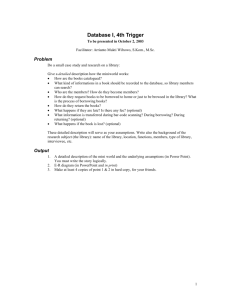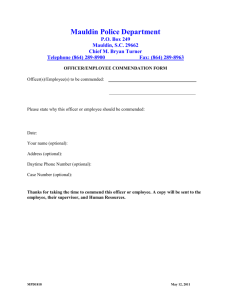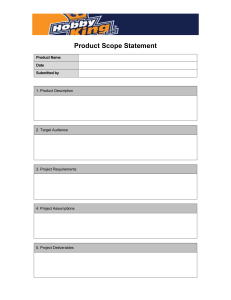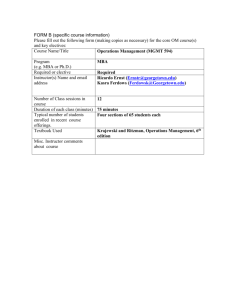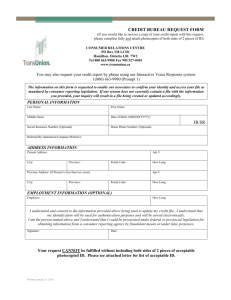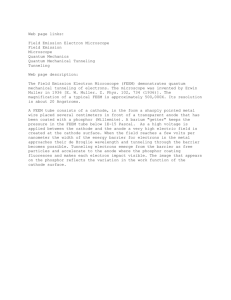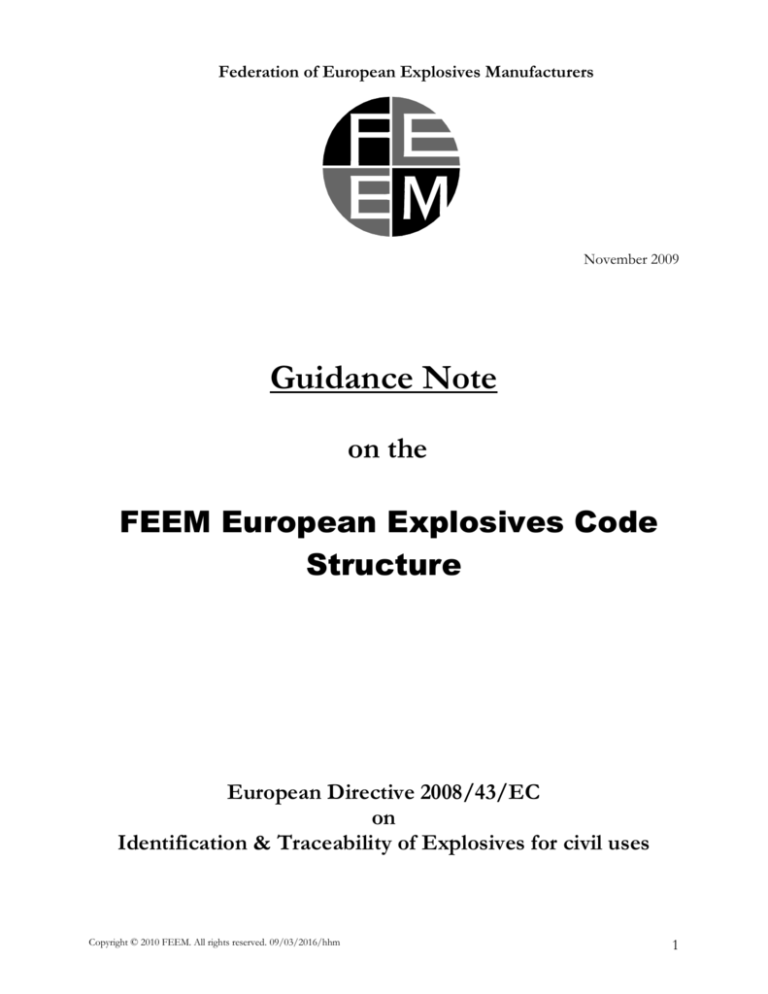
Federation of European Explosives Manufacturers
November 2009
Guidance Note
on the
FEEM European Explosives Code
Structure
European Directive 2008/43/EC
on
Identification & Traceability of Explosives for civil uses
Copyright © 2010 FEEM. All rights reserved. 09/03/2016/hhm
1
1. - BACKGROUND
This FEEM Guidance document has been prepared to outline the method adopted by FEEM Members to achieve a harmonised system for the purpose of implementing the European Commission’s
Directive 2008/43/EC to establish “a system for the identification and traceability of explosives for
civil uses”, and the associated national legislation. The system being recommended is not binding on
any FEEM Members, but the adoption and adherence to it shall minimise logistical problems
throughout civil explosives supply chains in Europe. It is also available for others to adopt should
such as system be seen as beneficial.
The European Directive on Identification & Traceability of explosives came into effect on the 4th of
April 2008. This directive is intended to establish a harmonised system for the unique identification
and traceability of all packaged explosives, detonators, reels of detonating cord, primers and other
explosives used in civil applications across the European Union. The directive was adopted into the
national legislation of each European Union member state on 5th of April 2009 with compliance
achieved throughout Europe by the 5th of April 2012. The requirements of the Directive apply to all
explosives manufactured, used and imported into the European Union from 5th April 2012.
The European legislation states that all packaged explosives for civil uses must be uniquely identified
and tracked at every stage throughout its life cycle This requires every explosives cartridge, detonator,
detonating cord (every 5 meters), reel of detonating cord, and primer to have a visibly readable
unique number on a label, with a barcode or RFID tag, and an associated data capture / recording /
reporting system. It is also a requirement for the records of every uniquely identified article to be
maintained and to be available for inspection for a period of 10 years.
2. - IDENTIFIYING AND TRACKING EXPLOSIVES
The most beneficial solution for identifying explosives items and tracking their location throughout a
supply chain at this current time is bar-coding technology; FEEM has decided to use the GS1 Standard (see Annex I). These technologies are therefore recommended to enable each individual explosives item to be allocated a unique number for the purpose of tracing that item throughout its life
cycle. The traceability of each item shall be achieved by way of databases, maintained by each User of
the explosives throughout the supply chain. If an item is misappropriated and later found with the
identification still intact, the point of manufacture can be identified by the unique number and the
item traced to the point at which the record ceases.
As there are many different manufacturers of explosives in Europe, (with others importing products), achieving a harmonised system of database management is essential for Users in the supply
chain to prevent a number of databases having to be used to maintain the records for each different
supplier. This has been achieved by designing and adopting a code structure that has sufficient flexibility to enable all companies use within existing IT systems. “Application Identifiers” are used within barcodes globally to provide code flexibility. FEEM has employed standard GS1 AI’s. These enable codes to be flexible, with individual fields within any code being in different positions in the
overall code, of various lengths and combinations on alpha, numeric and alpha-numeric characters.
Application Identifiers are not normally visible within a code, but if they were, they are recognised by
being two, three or four digit numbers within brackets. These AI’s are incorporated within 1 dimensional and 2 dimensional barcodes, and provide the required flexibility for the various fields within a
database.
Copyright © 2010 FEEM. All rights reserved. 09/03/2016/hhm
2
The following code structure with associated application identifiers, assigned to achieve harmonisation of explosives coding is the European Standard for all FEEM members:
Field
Digits
Format
Application
Identifier
AI Description
Length
Notes
Country
& Production
Site No.
5
AlphaNumeric
(90)
Mutually agreed
between trading
partners
Variable but
used as a
fixed number
to 5 digits
Mandatory to
comply
with Directive e.g.
FR002 – France,
2nd site
Unique
Item No.
OR Logistical
Unit No.
30
AlphaNumeric
(250)
Secondary Serial
No.
Variable up to
30 characters
Mandatory to
comply with Directive
Production Date
6
Numeric
(11)
Product Date
(YYMMDD)
Fixed
Optional
Product
Code
30
Alpha- Numeric
(240)
Additional Product Identification
Assigned by
Manufacturer
Variable up to
30 characters
Optional
Batch
Number
20
AlphaNumeric
(10)
Batch or lot number
Variable length
Optional
Quantity
8
Numeric
(37)
Count of items
contained in a
logistic unit
Variable
Length
Optional
Net Explosive
Quantity
6
Numeric
(310n)
Product net
weight in kgs
Fixed
Optional
Unit of
Measure
6
Numeric
(311n-316n)
Specified units of
measure e.g.
length / volume
etc.
Fixed
Optional
Gross
weight
6
Numeric
(330n)
Gross weight Kgs
Fixed
Optional
Internal
Use
30
AlphaNumeric
(91) – (99)
Company Internal
Information
Variable length
Optional
Application Identifiers
The applied “Application Identifiers” will enable harmonisation by recognising the format of a database in which the information is being received in. This enables the explosives code structure to be
flexible. Individual fields within the overall code at different positions with various lengths and combinations on alpha, numeric and alpha-numeric characters are possible. The Application Identifiers
are not normally visible within a code, but if they were, they are recognised by being two, three or
four digit numbers within brackets.
Copyright © 2010 FEEM. All rights reserved. 09/03/2016/hhm
3
Code Structure
The code structure is build up in such a way that it will achieve the requirements of the EC Directive
on Identification & Traceability of explosive for civil uses (the mandatory part) as well as the requirements of the industry concerning logistical and product information.
The mandatory requirements are that it contains three fields, namely
1. Country
2. Production site number within the country where the explosives where manufactured
3. Unique number associated with the country and site.
The Country and Production site number must be the first fields on the readable section of a label
applied to each explosives item.
The rational behind the identification (allocation a unique number to every explosives article) and
traceability (establishing records of where every identified explosives article has been from point of
manufacture to final use for a period of 10 years) is to identify an article that was illegally removed
from the normal supply chain. On recovery of an explosives item, (presuming that the label is still
attached) the regulatory/law enforcement authorities shall identify the country and production site
and commence their enquiries at that point, following the articles movements down the supply chain
to the final point that information is available on it. This then fulfils the regulatory obligations.
However, as a system to achieve the mandatory requirements is being established, the opportunity to
obtain associated benefits has been exploited by the members of the Federation. These arise from
some of the following areas:
1.
2.
3.
4.
5.
6.
7.
8.
9.
Security
Stock counting
Stock segregation (i.e. non conforming products)
Stock evaluation
Quality issues
Explosives Licence compliance (NEQ)
(SAP / MRP / ERP
Raw materials scheduling
Logistics
To enable these benefits to be realised, additional (optional) fields in a coding structure have been
added. It would be for each FEEM member to decide whether they include these for their own purposes, or for the benefit of their down stream customers who would achieve business benefits by
having this data available to them. However, when using the optional fields the same AIs should be
used.
Copyright © 2010 FEEM. All rights reserved. 09/03/2016/hhm
4
Mandatory fields
1. Country & Production Site Number
The EC Directive states that the first two digits of the unique number must be alpha characters and
must represent the country of manufacture. The EC Directive also states that digits 3, 4 & 5 of the
code must be numeric characters, to represent the production site within the country. This number
will be allocated by the National Authority. In order to simplify this, the code structure combines
these two requirements and assigned AI (90) which is defined within the global standards as “Mutually agreed between trading partners”.
2. Unique Item Number
With the Country & Production Site Number on every explosives article, this enables each company
to design a system of unique numbering to meet their individual requirements. Given companies
existing systems, it is necessary to ensure that up to 30 characters are available for this field. The AI
(250) has been assigned, which is known as a “Secondary Serial No.” as this permits up to 30 alpha
numeric characters to be used.
This Unique Item Number field would also be used for identification of Logistical Unit numbers, i.e.
a bag, a case, a pallet, etc. providing identification & traceability at that level also.
3. Readable Code on labels
The EC Directive requires a readable number to be printed / attached on each explosives article. It is
therefore mandatory (to enable any later traceability) and sufficient for the Country Code, the Production site number and the Unique number to be displayed.
Optional Fields
1. Production Date
The addition of the production date within the code captures the date on which the traceability of
the unique number commenced. It may be used in association with the Unique Item number, making
the number unique by virtue of the date being incorporated. From the choice of “Date” fields available within the global standards, “Production Date” (11) was considered to be the most appropriate
for the purpose for which it is being used. It would be displayed in the format of YYMMDD.
2. Product Code / Article Number
The additional of a “Product Code” within the structure introduces additional functionality for databases. Systems can report on products stored in locations, aged stock, valuation reports, etc. The
global standard has a provision for “Additional Product Identification” (240) with the capability of
30 variable alpha-numeric characters and hence meeting the requirements of all companies present.
3. Batch Number
The EC Directive introduces a requirement of individual item level identification and traceability.
This is evidently more stringent than batch-tracking, however some companies may desire to retain
Copyright © 2010 FEEM. All rights reserved. 09/03/2016/hhm
5
the capability to Batch track. This was therefore included in the code, with the global standard
“Batch No.” (10) being assigned. A total of 20 alpha-numeric characters can be used, with variable
length of the field.
4. Quantity
While “Quantity” isn’t relevant at individual item level labelling (as it is always “1”), knowing the
number of items contained within a bag or case, or number of cases on a pallet, etc. is beneficial.
This would enable systems to be designed such that they count the number of items being located
into a logistical unit, and the number of items (which may be different Product codes) within a logistical unit. The “Quantity” shall always be indicated by a variable length number up to a maximum of
8 digits and AI (37).
5. Net Explosive Quantity
The Net Explosives Quantity is widely used within the explosives industry for regulatory and management purposes. Incorporating this information into a barcode at item level enables the NEQ at
any location to be available at all times when this system is being used. This could be in a manufacturing facility, a magazine or on a delivery truck, as examples. The global standard for “Product net
weight in kilograms” (310n) enables this. Up to 6 numeric digits can be used to display this with the
decimal place being repositioned as necessary.
6. Units of Measure
Explosives articles may be marketed (and consequentially tracked) in a range of units of measure, i.e.
weight, length, volume, etc. The global standards specify AI’s (311n) to (316n) as units of measure
that can be applied and incorporated within the barcode (if applicable)
7. Gross Weight
Tracking of explosives articles shall be conducted at item, bag, case, pallet and container level as appropriate. At the larger logistical levels, the gross weight could be of importance. A provision for
“Gross Weight” has therefore been included in the proposed code structure and the global standard
of “Gross Weight” (330n) to (335n) adopted.
8. Company Internal Information
AI’s (91) – (99) are specified within the global standards for the purpose of “Company Internal Information” such as
Type of packaging
Production machine
Group
Shelf life
Code status and others
These AI’s were deliberately avoided as some FEEM members are currently using these for their
own purposes – as intended within the GS1 Standard.
Copyright © 2010 FEEM. All rights reserved. 09/03/2016/hhm
6
Annex I contains a complete example, with all the necessary technical explanations, about how to
encode following this FEEM criteria.
3. - SENDING INFORMATION BY ELECTRONIC MEANS
FEEM has also decided to use a XML format when the information has to be sent by electronic
means; the Annex II contains an example of it.
Copyright © 2010 FEEM. All rights reserved. 09/03/2016/hhm
7
ANNEX I
The encoding structures
The FEEM code structure is based on GS1 standards and it can be encoded with GS1 Data Matrix
or GS1-128 symbols. This issue is for GS1 Data Matrix symbol, for GS1-128 linear barcode refer to
the appropriate GS1-128 structure documentation.
The general version Data Matrix ECC 200 supports various encoding structures: ASCII, ISO/IEC
646, C40, Text, X12, EDIFACT and Base 256. The simplest solution, and the one mandated by the
GS1 standards, is to encode data using the subset of ISO/IEC 646 (equivalent to ASCII table
256) for all the information.
When encoding data in accordance with the GS1 System using GS1 Data Matrix, three principle
rules apply:
The Data Matrix ECC 200 must have a leading FNC1 character in the first position to indicate
that the symbol is GS1 Data Matrix. FNC1 is a special, non-printable, character. It is often inserted using a double-byte “Latch to extended ASCII” but this is system dependent.
The GS1 Application Identifiers (or AIs) are used for all encoded.
Only the characters contained in ISO 646 subset may be used. It should be noted that spaces
cannot be encoded.
GS1 Element Strings
Although it is possible to encode any type of data in the general Data Matrix ECC 200, when using
GS1 Data Matrix the data must be structured according to the rules of the GS1 System. Element
strings begin with an Application Identifier which is then followed by the data that the AI denotes.
The system can be characterized by:
A standard format for encoding data and bar coding specifications.
A symbol architecture that allows multiple data elements (item identification, production date,
batch number, etc.) within a single bar code.
* In FEEM code structure only FEEM AIs can be encoded.
FEEM AIs
AI
(250)
Field
Country & Production
Site No.
Unique Item No
(11)
(240)
(10)
(37)
(310n)
(311n-316n)
(330n)
(91) – (99)
Production Date
Product Code
Batch Number
Quantity
Net Explosive Quantity
Unit of Measure
Gross weight
Internal Use
(90)
Digits
5
Format
Alpha-Numeric
Length
Variable but fixed (5)
Notes
Mandatory
30
Alpha-Numeric
Variable
Mandatory
6
30
20
8
6
6
6
30
Numeric
Alpha-Numeric
Alpha-Numeric
Numeric
Numeric
Numeric
Numeric
Alpha-Numeric
Fixed
Variable
Variable
Variable
Fixed
Fixed
Fixed
Variable
Optional
Optional
Optional
Optional
Optional
Optional
Optional
Optional
Copyright © 2010 FEEM. All rights reserved. 09/03/2016/hhm
8
Each AI and its associated data can be encoded into a GS1 Data Matrix symbol in the same way and
using the same logical rules as encoding data in the linear bar code symbol GS1-128. Application
Identifiers should be clearly recognizable to facilitate key entry. This is achieved by putting parentheses around Application Identifiers in the Human Readable Interpretation under the symbol. The
parentheses are not part of the data and must not be encoded in the bar code.
Function 1 Symbol Character (FNC1)
GS1 Data Matrix uses a special start combination to differentiate the GS1 Data Matrix symbol from
the other Data Matrix ECC 200 symbols. This is achieved by using the Function 1 Symbol Character
(FNC1) in the first position of the data encoded. It enables scanners to process the information according to the GS1 System Rules. The FNC1 is encoded in two separate ways within GS1 Data Matrix:
Start character (ASCII 232)
Field Separator (ASCII 29: <GS>)
When used as part of the special combination – use ASCII 232
When used as a field separator (see Concatenation,) - ASCII 29 : <GS>
Concatenation
Using GS1 Data Matrix, it is possible to concatenate (chain together) discrete Application Identifier
(AIs) and their data into a single symbol. When the AI data is of pre-defined length, no field separator is required when the next Application Identifier and data are concatenated immediately after the
last character of the previous AI data. Where the AI data is not of pre-defined length, it must be
followed by a field separator when concatenating more AIs. The FNC1 character acts as field
separator. The FNC1 is the character that has the ASCII value 29 (or group separator <GS>). A
FNC1 separator is not required after the last AI and last data encoded in the symbol independent
of whether the field is of pre-defined length or not.
Pre-defined length vs. fixed length element strings
A common mistake is to believe that any GS1 Application Identifier with a fixed data field is never
followed by a FNC1 separator when concatenated. In fact, there is a table which defines the fixed
data fields. This table of that shows every GS1 Application Identifier was published when they were
first introduced.
For all GS1 AIs that start with two digits that are not included in this table, it is mandatory to
follow the data with the field separator FNC1 if it is not the last data encoded in the symbol.
First 2-digits of the GS1
Application Identifier (AI)
00
01
02
03
04
11
12
13
14
15
16
FEEM
Number of digits
(AI and Data Field)
20
16
16
16
18
8
8
8
8
8
8
Copyright © 2010 FEEM. All rights reserved. 09/03/2016/hhm
First 2-digits of the GS1
Application Identifier (AI)
17
18
19
20
31
32
33
34
35
36
41
FEEM
FEEM
Number of digits
(AI and Data Field)
8
8
8
4
10
10
10
10
10
10
16
9
Human Readable Interpretation
Application Identifiers (AIs) should be clearly recognizable within the Human Readable
Interpretation to facilitate key entry in the event that the symbol cannot be scanned. This is
achieved by putting the AI between parentheses. The parentheses are not part of the data and are not
encoded in the symbol. This is in clear contrast to the use of the FNC1 which must be encoded in
the symbol, when used as a start or separate character, but never appears in the Human Readable
Interpretation.
* In FEEM code structure only AIs 90 and 250 are mandatory for human readable interpretation.
Copyright © 2010 FEEM. All rights reserved. 09/03/2016/hhm
10
FEEM Code Examples
Example 1: Mandatory data (AIs 90 and 250)
String to encode:
<FNC1>90AT001<GS>25009E310120000001
Example 2: Mandatory data (AIs 90 and 250), production date (11), product code (240) and
quantity (37).
String to encode:
<FNC1>90AT001<GS>25009E310120000001<GS>11090131240PRODUCT_CODE<GS>37500
* Production date (11) is not ended by <GS> because it has a pre-defined length.
Copyright © 2010 FEEM. All rights reserved. 09/03/2016/hhm
11
Example 3: Mandatory data (AIs 90 and 250), production date (11), product code (240), batch
number (10) and net quantity (310n)
String to encode:
<FNC1>90AT001<GS>25009E310120000001<GS>11090131240PRODUCT_CODE<GS> 310300015210AB123/09
* Production date (11) and net quantity (3103) are not ended by <GS> because they have a pre-defined length.
Example 4: Small items (GS1-128)
Encoded: Mandatory data (AIs 90 and 250) Human Readable: AIs 90 and 250
Encoded: Mandatory data (AIs 90 and 250) Human Readable: AI 90
Encoded: AI 90
Human Readable: AI 90
* The maximum data length to encode on a GS1-128 symbol is 48 characters including the AI numbers and group separator characters.
This document has been prepared on the basis of the document "GS1 Data Matrix an introduction
and technical overview of the most advanced GS1 Application Identifiers compliant symbology" by
GS1.
Copyright © 2010 FEEM. All rights reserved. 09/03/2016/hhm
12
ANNEX II
XML File
XML provides a standardized and predictable structure for electronic business messages, enabling
business partners to communicate business data rapidly, efficiently and accurately, irrespective of
their internal hardware or software types.
This is a XML structure example to transmit FEEM code data to anyone; two examples are developed below.
Copyright © 2010 FEEM. All rights reserved. 09/03/2016/hhm
13
XML Item
Root Element
Attribute
Element
Element
Element
Element
Element
Element
Element
Element
Element…
Attribute
Element
Element
Element
Element
Element
Element
Element
Element…
Attribute
Attribute
Element
Element
Element
Element
Element
Element
Element
Element
Element
Element
Element
Element
Element
Field Name
Type
Packing List
File Version
Shipment Number
Shipment Date
Delivery Note
Sender Name
Sender Code
Receiver Name
Receiver Code
Summary Items
Mandatory
Mandatory
Optional
Optional
Optional
Optional
Optional
Optional
Optional
Optional
Summary Item
Item Number
Product Code
Description
Lot Number
Quantity
Optional
Optional
Optional
Optional
Optional
Optional
Unit_Of_Measure
Count_Of_Units
Items
Item
Item Number
Item Type
GS1_Code
Country Code
Site Code
Unique_Number
Product_Code
Description
Production_Date
Lot_Number
Quantity
Optional
Optional
Mandatory
Mandatory
Optional
Optional
Mandatory
Optional
Optional
Optional
Optional
Optional
Optional
Optional
Optional
Unit_Of_Measure
Count_Of_Units
Number_Of_Items
Items
Optional
Optional
Optional
Optional
Copyright © 2010 FEEM. All rights reserved. 09/03/2016/hhm
Description
Main root element.
XML File version
Number of shipment.
Date of shipment (YY/MM/DD).
Delivery note number.
Manufacturer name, production site…
Sender id, sender reference, AI 90…
Customer name…
Customer id, customer reference….
Root of items. Summarized data by Product or Product-Lot
No.
Item element (n elements at the same level).
Position number in their parent's root.
AI 240. Manufacturer product code.
Manufacturer product description.
AI 10. Batch or lot number.
AI 31Xn. Quantity in units, kilograms, meters, liters (with
decimal point as "point").
Unit of measure for the quantity field (U, KG, M, L…).
AI 37. Count of detonators, cartridges, sacks, reels…
Root of items.
Item element (n elements at the same level).
Position number in their parent's root.
Type of package: pallet, outer case, bag, item…
Complete code printed on the item (AIs included).
AI 90. The originating country code of the item
AI 90. The originating site code of the item
AI 250. Unique item number.
AI 240. Manufacturer product code.
Manufacturer product description.
AI 11. Production date (YY/MM/DD).
AI 10. Batch or lot number.
AI 31Xn. Quantity in units, kilograms, meters, liters (with
decimal point as "point").
Unit of measure for the quantity field (U, KG, M, L…).
AI 37. Count of detonators, cartridges, sacks, reels…
Number of child items.
Recursive root of items.
14
Mandatory data example
Copyright © 2010 FEEM. All rights reserved. 09/03/2016/hhm
15
Full data example
Copyright © 2010 FEEM. All rights reserved. 09/03/2016/hhm
16
Copyright © 2010 FEEM. All rights reserved. 09/03/2016/hhm
17
Copyright © 2010 FEEM. All rights reserved. 09/03/2016/hhm
18


